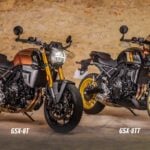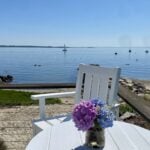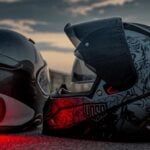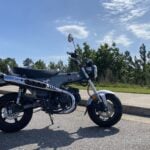Into The Wild Wet
Dave Wensveen hates rain. Few riders like the rain, but Dave just flat out despises it. The only thing my riding comrade, hardcore mile muncher and guest tire tester loathes more than rain is dirt. Long, endless miles of dirt. He still blames me for that one.
Yet if you ride in the Pacific Northwest then you know that into every ride a little rain must fall. Just not this year. We rode through most of the West anticipating that somewhere, somehow, we would find nature’s rain for the highly anticipated wet weather tire test of Dunlop’s Roadsmart IV vs Michelin’s Road 6, our participants in year two of our tire shootout series. Instead we found heat, snow, even a biblical plague of grasshoppers but not a single drop of rain. So to answer the question that both of my readers have been asking, we traversed thousands of miles to some of the best riding in the country, the place where it rains every afternoon: Colorado.
“Why are we doing this, Ted? We shouldn’t be here. Is this supposed to be fun??” When Dave complains, I just turn my Cardo unit off.
If you haven’t ridden a sport bike in Colorado, please don’t go. The mountains are ugly, the beer is warm, the locals are grumpy, the roads are horrible and the off key musicians at the lame honky-tonks don’t even know what guitar they are playing. In other words, just stay away so Dave and I can have Colorado to ourselves, because a crowded paradise is no paradise at all.
Especially stay away from Cottonwood Pass. I was one of the first group of riders across Cottonwood Pass after it was fully paved in 2019 and it is spectacular. The billiard table smooth asphalt and never ending second gear corners sprinkled with fourth gear sweepers weave among the pines to take you to over 12,000 feet and across the Continental Divide. Other than The Million Dollar Highway, it might be one of my favorite roads in the best riding state in America.
Official Road Dirt wet tire testing grounds.
And it rains there constantly. Precipitation on Cottonwood Pass arrives in many forms from a damp and soggy permeating mist to weighty, painful, grenade sized drops that arrive with little warning, turning the flat pavement into a shiny wet sheen at over two miles of elevation. Any pavement texture to improve traction would be welcome, but instead you rely on your tires. In this test those tires are Dunlop’s Roadsmart 4 and Michelin’s Road 6, both mounted on identical 5th generation Honda VFRs.
Michelin’s Road 6, with it’s deep siping and button hole reservoirs has earned a reputation for excellent wet handling, but Dunlop’s Roadsmart IV shined in last year’s wet weather test on Washington’s Rattlesnake Grade. However, that was last year, and during that test the Roadsmart IVs were new. Now they were nearing end life. Many months of travel and testing across the west had both sets of rubber at over 6,000 miles and severely squared off.
New tires perform better in the wet when new, when deep tread allows for more water evacuation, so only nut jobs like us put over 6,000 miles on tires then ride across the Continental Divide, in the rain, and the cold, at full trot, several times. Yet we had to. We wanted to see how these tires handled the wet, when you need them the most, with the tires at their worst. Pushing them to the edge in this state should tell us which one would better handle the wet when worn, a fear every rider faces. Here is what we discovered.
Dunlop’s Roadsmart IV and Michelin’s Road 6 about 6,000 miles in, dirty and wet from testing. A close look will find the wear bars on each starting to emerge.
To start, we hot lapped Cottonwood in the dry for a test baseline. Grip was still abundant with both tires, visibility was unlimited and everything was right in the world. On the return trip, weather happened. Mist and rain blanketed, temperatures dropped and visibility vanished. Just what we wanted. I think. Are we crazy? Dave says yes. Did I mention how much he hates rain?
Cottonwood Pass in the dry for our baseline. Then, in wet conditions for our test.
I began the wet test on Dave’s 2001 Honda VFR800 shod with Dunlop’s Roadsmart IV. Under a semi-relaxed pace, the Dunlops didn’t budge. Braking felt solid, cornering was still nimble given the Dunlop’s handling edge and the Roadsmarts accepted throttle on exit without drama. So, I upped the pace a touch and pushed my braking markers deeper, increased my lean angles and rolled on a tad more throttle on exit. Still, the Dunlops held.
Nearing Cottonwood’s 12,126’ summit the temperatures dropped to the low 50s, visibility decreased and chilly water clung to the smooth pavement. On the last couple of miles I pushed the pace on the Dunlops into the questionable, possibly stupid category. Still they held. It would take an ugly braking technique to get the Dunlops to slip the front or a very greedy throttle hand to slide the rear. Cornering was still sure and exit traction as solid as any sane rider could want. I had pushed the Dunlops as far as I felt comfortable and came away impressed, so I dialed back the pace to the summit. After all, I wanted to keep the bike for the rest of the test and I felt satisfied with the results.
There is a reason this is the only motorcycle,… heck,… the only vehicle at Cottonwood Pass’ summit. If it looks cold, grey and miserable, that’s because it is.
At the summit, I jumped from Dave’s Dunlop shod 2001 Honda VFR to my Michelin Road 6 wearing 1998 Honda VFR. On the downhill stretch I started with the same slightly brisk pace, the same lean angles and same corner throttle as with the Dunlop bike. Michelin’s Road 6 held steady. The downhill trajectory gave good opportunity for testing front traction, so I did. Front brake pressure was increased gradually from corner to corner, yet I could not get the Road 6 to give way. Corner feel was secure and the rear held under throttle. As with the Dunlops, the Michelins increased my wet weather confidence with every corner.
Then a cow appeared out from the mist into the middle of the road. Not seeing it until the last second due to poor visibility I got on the front binders firmly, then harder and harder until the nose of the VFR dove to the pavement. Future beef jerky avoided, not once under this hard braking incident did the Michelins budge. This was not a panic stop, but hard enough to test the 6,000 mile Road 6s. Their wet weather grip was high.
A few miles later a deer jumped onto the road. Evidently someone by the side of the road was pushing all of Colorado’s herbivores into my path. One more hard stop to avoid smacking Bambi and one more time the Michelin’s held. Although not planned, my pair of hard stops to avoid nature’s jailbreak gave me even more confidence in the Road 6s.
The Michelin Road 6 mounted VFR (at left) and the Dunlop Roadsmart IV mounted VFR (at right).
Only because of the zoo parade avoidance stops would I give a very slight wet grip win to the Michelin Road 6s. They gave me the confidence to securely grab front brake and add pressure until I knew I would not flatten wildlife.
However, the wet pace I set with the Dunlops was ridiculously brisk. Braking was sure and the rear never budged on corner exit. I did not have the opportunity, or need, to hard stop the Dunlops, but I would not hesitate to put my faith in their wet grip. I just came away with a touch more confidence in the Michelins.
Please remember, all of this was done in the name of testing. Most of us dial back our pace in the rain and your brain is still the best tool for getting you home in the wet. Ride like I did here in the wet long enough like a fool (yes, I still require adult supervision) and you will go down eventually, no matter what tire you ride.
Dave’s body language shows how much he enjoys wet weather testing. It took much pizza, adult beverages and live music to get him back to normal.
If you have many thousands of miles on the Roadsmart IV or the Road 6, and need traction while late braking after an ill timed pass, or have an emergency stop to avoid venison or a future Big Mac, then either of these tires will have your back. Even with over 6,000 miles on them, wear bars beginning to emerge, and taking them to over two miles of elevation across the Continental Divide, on mirror smooth wet pavement, in the driving rain, with poor visibly, and temperatures in the low 50s, and some four legged protein brake checks, both tires got us home safely.
Getting home safely is, after all, what every rider wants from their tires. Especially if they hate the rain.
Ted

































Excellent article; well written and informative.
Glad it was useful Barry. And stay away from Colorado. Please.
This was a very good article. I recently took a road trip from SW Washington state to Houston, TX and returning via NM, AZ and CA on a Kawasaki Concours 14. The tires on her are Road 6s and part of my trip took me through Colorado. As you correctly stated it started raining as the altitude increased and it didn’t stop until I got to Denver. This is my second set of Micheliens, the first was Road 5 and I got about 12k miles out of them.
Good road trip Dave, and a good tire choice.
Ted,
Been on the Cottonwood section with exactly the same conditions!
On my 5th set of RS-4’S. Can’t be beat for performance, (all facets). Found that I get better mileage than the “M” Brand. Best bang for the $$!!!
I have often wondered the difference between the much loved RS4s and the Road 6s. However, we try to test the most recent rubber from manufacturers. They are a good tire for the predictably unpredictable Colorado weather.
Good article. Although, to be fair, you should have tried to hard stop on the Dunlops to see whether they could match the Michelins before giving them the nod.
Anyway, glad you enjoyed Cottonwood. I live about 25 mls from it’s eastern side. In the summer I have to ride it at least twice a week to convince myself how bad it is. Just be careful of the gravel that trailers pull into the hairpins.
It’s almost as much fun in the winter, when the handlebars are attached to skis and pushed by a track.
I hard stopped the Dunlops as far as I felt comfortable while still keeping the bike upright. And remember, our bikes do not have outriggers, so we can only push them so far.
And if you live 25 miles to the east of Cottonwood, stop by Brown Dog Coffee, one of my favorites in Buena Vista.
Hey guys. This series of tyre tests by real world riders is just great!
I’m a fan. Keep it going!
We certainly plan to, Abraham!
Glad you are enjoying it Abraham. We put a lot of work, a lot of miles and a lot of thought into trying to give you the best facts and opinions possible. Some days are enjoyable. Some days are work. But knowing readers find the results useful keeps us going. That and coffee. Lots of coffee.
Thanks for the series. Need new tires for my 2009 BMW K1300GT. Live in Ohio and planning trips for next year since I have retired. Any idea of tire life from your experience?
Roland, I’m looking at about 10,500 mls (8,000 done with 2/32 of tread left) from a set of RS4’s on my Ducati SuperSport 950. The most I’ve ever got from any tire, including Michelin Road 6’s. But, your BMW is heavier and more powerful.
Informative and entertaining. Bravo 👏
Tire life is our next and final installment in the series. Stay tuned.
What a fantastic way to write a tire review! Thank you guys so much for your hard work and this joyful reading experience
Glad you find it useful. Our misery is your entertainment.
All your tire tests are an excellent read! I’ve recently installed a rear IV on my KTM GT and after wearing off the front Metzeler, will change the front as well. as for longevity, any tire that can provide the grip you indicate in both dry and wet, and still get 6,000 miles (10,000km) or more is more than adequate for me. I happy changing out my tire when tread life gets low, but still not completely worn out.
I should have specified the original tires were the Bridgestone Battlax A41 the adventure touring version. They don’t handle as well as some. I replaced them with the Bridgestone Battlax T31 the sport touring version. the handling is better.
We got more than 6,000 miles from each tire. Mileage report coming out soon.
I love riding in the rain, and fully trust my MPR4 GTs on my R6 with 84k miles. Currently running Roadsmart IV on my 1260s Multistrada and while I have yet to have something jump in front of me, I fully trust them in the wet.
I would be interested in your thoughts on the Bridgestone Battlax. I had good results with them but I don’t ride as hard as you do. They came on my Suzuki V Strom 1050xt when it was new. I had 12k on them and the back tire was bald but not showing cords yet when I changed it.
Love my Pilot 6’s. 2nd pair on my 2020 1050XT V-Strom. I have ALOT of confidence in these tires for cornering and braking compared to the Bridgestone BattleAx that came from factory stock!
Since both you and the above reader have asked, I took off a pair of Bridgestone Battlax T32 before we started our first tire test. It is hard to tell without a back to back comparison like we are doing now, but I did ride them on the same roads at the same mileage as our other three tires tested here. I got some weird heat checking on the sides while on our way to Alice’s. I have never seen on any other tire I have tested. These might be a tire for Sport Tire Shootout year 3.
I love riding in the rain, and fully trust my MPR4 GTs, on my R6 with 84k miles. Currently running Roadsmart IV on my 1260s Multistrada and while I have yet to have something jump in front of me, I fully trust them in the wet.
I love riding in the rain and fully trust my MPR4 GTs. Running Roadsmart IV on my 1260s Multi and while I have yet to have something jump in front of me, I fully trust them in the wet.